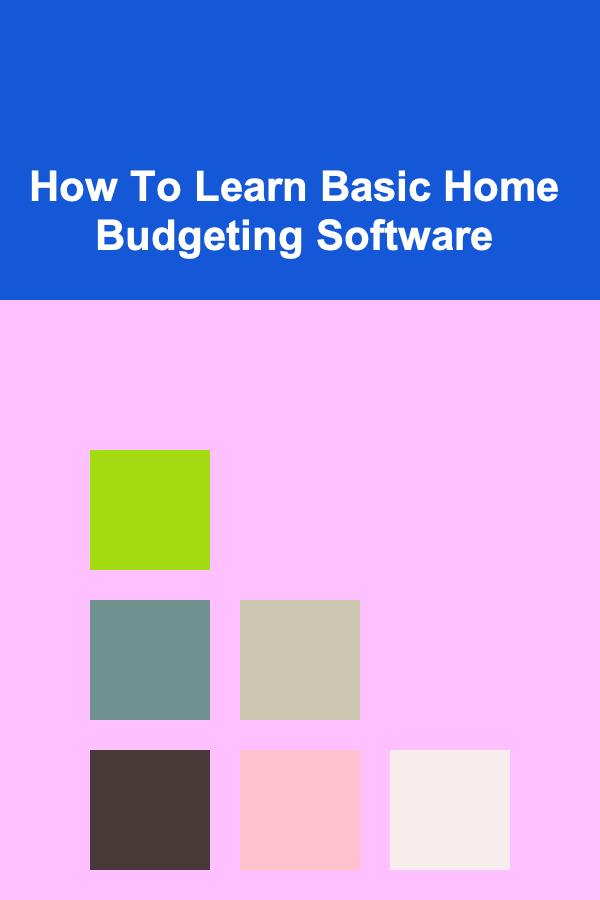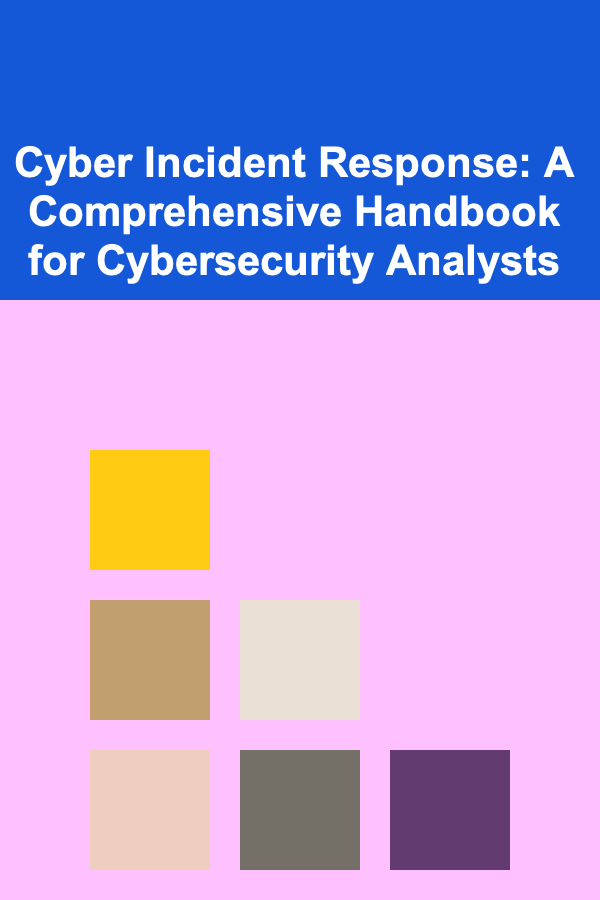
How To Learn Basic Home Budgeting Software
ebook include PDF & Audio bundle (Micro Guide)
$12.99$5.99
Limited Time Offer! Order within the next:

Managing finances at home can be challenging, especially when you're trying to balance expenses, savings, and long-term financial goals. A powerful tool for tackling this task is home budgeting software. These programs offer a structured way to track your income, expenses, and savings, helping you gain insight into your financial habits and ultimately make better decisions with your money. This article will guide you through the process of learning basic home budgeting software, with an emphasis on understanding its functions, setting it up, and making the most of the features available.
Why You Should Use Budgeting Software
Before diving into how to learn home budgeting software, it's important to first understand why it's beneficial. Traditional pen-and-paper methods of budgeting can be time-consuming, inaccurate, and difficult to manage as your finances grow more complex. On the other hand, budgeting software offers numerous advantages:
1. Automation
Most budgeting software can sync with your bank accounts and credit cards, automatically tracking your spending in real-time. This reduces manual entry errors and saves you time.
2. Easy Access to Financial Data
With cloud-based budgeting software, you can access your financial information from any device, anytime. This feature provides you with more flexibility and ensures that you're always on top of your financial situation.
3. Better Financial Planning
By having a clearer picture of your spending patterns, you can set realistic goals for savings, paying off debt, or planning for big purchases. Budgeting software often includes forecasting tools that can help you project future expenses and income.
4. Expense Categorization
Budgeting tools help categorize your expenses automatically, allowing you to see exactly where your money is going. This makes it easier to adjust your spending habits and identify areas where you can cut back.
Choosing the Right Home Budgeting Software
The first step in learning budgeting software is selecting the right one for your needs. There are many options available, each offering different features. When choosing software, consider the following:
1. User Interface
Make sure the software has an intuitive and easy-to-navigate interface. The more user-friendly it is, the easier it will be to learn and use.
2. Compatibility
Check if the software is compatible with your devices and operating systems. Cloud-based tools are generally accessible via mobile apps or browsers, while some software may be limited to desktop computers.
3. Cost
There are both free and paid budgeting tools available. Free tools, such as Mint, can be a good starting point. However, paid options like YNAB (You Need A Budget) and EveryDollar often come with more features and better customer support.
4. Features
Look for features that meet your specific needs. Basic functions like expense tracking, income management, and bill reminders are essential. Some software may also offer debt tracking, investment management, and savings goal setting.
5. Security
When handling sensitive financial data, security is crucial. Make sure the software uses encryption and follows best practices for data protection.
Setting Up Your Budgeting Software
Once you've chosen the right software, it's time to set it up. Although each software program may have its unique setup process, the basic steps are generally the same.
Step 1: Create an Account
Most budgeting software will require you to create an account. If you're using a paid program, you'll need to provide payment information. Creating an account allows you to store your data securely in the cloud, making it accessible from multiple devices.
Step 2: Link Your Bank Accounts
One of the most powerful features of budgeting software is its ability to sync with your bank accounts and credit cards. By linking these accounts, the software will automatically import your transactions, helping you avoid manual data entry.
Most software allows you to connect accounts from a variety of institutions, including banks, credit unions, and credit card companies. You'll typically need to enter your login credentials for these accounts, and the software will pull your recent transactions.
Step 3: Set Up Your Budget Categories
Next, you'll need to set up categories for your expenses. Some software will automatically create default categories, such as groceries, transportation, and utilities. However, you can usually customize these categories to suit your specific needs. For example, you may want to add categories for dining out, entertainment, or household maintenance.
Step 4: Input Your Income and Expenses
Once your categories are set up, the next step is to input your income and recurring expenses. This can include:
- Income: Your salary, side hustles, or any other sources of income.
- Fixed Expenses: Regular bills like rent/mortgage, utilities, insurance, and loan payments.
- Variable Expenses: Categories like groceries, gas, and entertainment that can fluctuate each month.
Budgeting software will often allow you to set up recurring transactions so you don't have to input the same expenses each month. This makes it easier to keep track of your spending over time.
Step 5: Establish Savings Goals
Budgeting software can help you set and track savings goals. Whether you're saving for an emergency fund, a vacation, or a down payment on a home, inputting these goals into your budgeting software can provide you with a clear timeline and actionable steps. The software will often allow you to automatically allocate a portion of your income to your savings goals, making it easier to reach them.
Step 6: Set Up Alerts and Reminders
Many budgeting tools offer alert and reminder features, which can help ensure you never miss a bill payment or exceed your budget in a certain category. Set up email or push notifications for due dates, budget limits, or account balances.
Using the Software to Manage Your Finances
Once your budgeting software is set up, you can begin using it to track your finances and make informed decisions. Here are some essential tasks you should regularly perform using your budgeting tool:
1. Track Your Spending
The core function of budgeting software is to track and categorize your spending. As you make purchases, the software will automatically assign them to the appropriate categories. Periodically review your spending to ensure it aligns with your budget. If you notice overspending in a particular category, it's time to adjust your habits.
2. Monitor Your Progress Toward Goals
Check your progress on savings goals and debt repayment. The software will often show you how much you've saved or how much further you need to go to reach your goals. This will help keep you motivated and on track.
3. Analyze Your Cash Flow
Most budgeting software provides a snapshot of your cash flow, showing how much money is coming in and going out. Reviewing your cash flow helps you understand whether you're living within your means or need to cut back in certain areas.
4. Generate Reports
Advanced budgeting software often allows you to generate detailed reports about your spending habits, income, and financial health. These reports can help you analyze your finances over a longer period, which can be helpful for making big decisions or adjusting your budget.
5. Make Adjustments
As you continue using the software, you'll likely need to adjust your budget to reflect changes in your income, expenses, or financial goals. This is a normal part of the budgeting process, and the software allows you to make these adjustments easily.
Overcoming Common Challenges with Budgeting Software
While budgeting software offers many benefits, it's not always smooth sailing. Here are a few common challenges and tips for overcoming them:
1. Data Sync Issues
Sometimes, budgeting software may not sync correctly with your bank accounts or credit cards, which can lead to incomplete or inaccurate records. If this happens, try manually syncing your accounts or contact customer support for assistance.
2. Difficulty Understanding the Features
It's normal to feel overwhelmed when using budgeting software for the first time. Take the time to explore the software's tutorials or help sections, and don't hesitate to reach out to support teams or online forums for guidance.
3. Staying Consistent
Consistency is key when it comes to using budgeting software. Set aside time each week to review your spending, update your categories, and make necessary adjustments. The more consistently you use the tool, the more effective it will be.
4. Managing Multiple Accounts
If you have multiple bank accounts, credit cards, or loans, it can be challenging to keep everything organized. Consider linking all your accounts to the software so everything is in one place. If your software allows it, you can create a separate budget for each account to keep things clear.
Conclusion
Learning basic home budgeting software is an essential skill that can help you gain control of your finances and make smarter financial decisions. By carefully selecting the right tool, setting it up, and using it regularly, you can create a sustainable and effective budget that helps you meet your financial goals.
Budgeting software is not a one-size-fits-all solution, and it may take some time to find the right software and become familiar with its features. However, with patience and consistency, you can master it and build a solid foundation for financial health and success.

Cyber Incident Response: A Comprehensive Handbook for Cybersecurity Analysts
Read More
How to Host a Mystery Party at Home with Fun Role Play
Read More
How to Make a Grant Reporting Checklist for Research Projects
Read More
How to Organize Time with a Study Calendar
Read More
The Digital Marketing Manager's Playbook: Driving Growth in the Digital Age
Read More
How to Understand the Concept of "Plausible Deniability"
Read MoreOther Products

Cyber Incident Response: A Comprehensive Handbook for Cybersecurity Analysts
Read More
How to Host a Mystery Party at Home with Fun Role Play
Read More
How to Make a Grant Reporting Checklist for Research Projects
Read More
How to Organize Time with a Study Calendar
Read More
The Digital Marketing Manager's Playbook: Driving Growth in the Digital Age
Read More